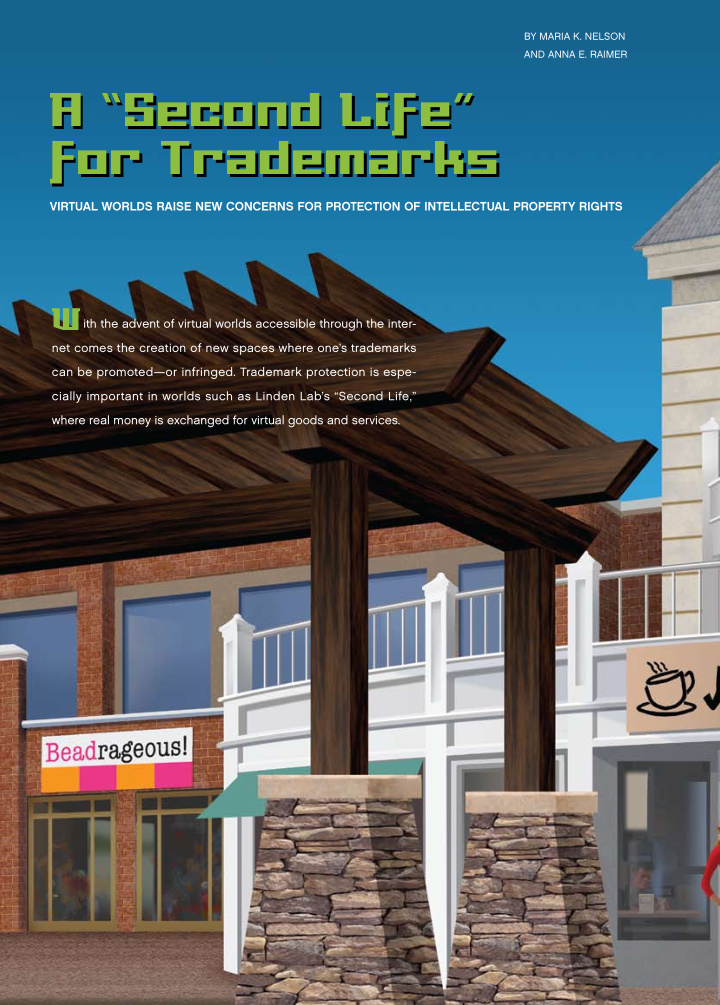



18 A“SecondLife” forTrademarks A“SecondLife” forTrademarks vIrtUAl worlDs rAIsE nEw concErns For ProtEctIon oF IntEllEctUAl ProPErty rIghts By MARIA K. NELSON AND ANNA E. RAIMER W ith the advent of virtual worlds accessible through the inter- net comes the creation of new spaces where one’s trademarks can be promoted—or infringed. Trademark protection is espe- cially important in worlds such as Linden Lab’s “Second Life,” where real money is exchanged for virtual goods and services.
19
20 money being exchanged. Second Life by giving away virtual fragrance bub- launched a new real-world perfume brand in that are targeted in the real world. Calvin Klein products), often to the same types of consumers real-life products (or virtual copies of real-life ally promote their brand images and market their value of leasing land in a virtual world to glob- Many companies have already recognized the Life translates to significant amounts of real American Apparel has a Second Life store where the number of transactions occurring in Second is presently worth only a fraction of a U.S. dollar, 500,000 Linden dollars. Though the Linden dollar tions ranging from 1 Linden dollar to more than 2007, there were more than 23 million transac- dollars at online currency exchanges. In October “Linden dollars,” which can be converted to U.S. monthly transactions amounting to millions of bles and offering some consumers real samples. avatars can purchase clothing to wear, much like coMMErcE In sEconD lIFE itsspaceand residents are internet users from across the globe who have created digital in 2003 to be “inhabited” by more than 11 million residents worldwide. these and owned by its “residents,” and it has exponentially grown from its opening the 3-D virtual world of second life is built plans. development forhotel givefeedback userstotour the clothing available from the real-world store. Hotelsallows Starwood ofitscars. newmodels purchase driveand avatarstest- Toyotalets The Second Life economy is supported by to virtual business. Interestingly, avatars engage in many of the Honorable Richard Posner, a judge on the United forum for testing, advertising, and selling both Moreover, Second Life offers companies a new consult with clients, or hold business meetings. are using Second Life to conduct job interviews, and market reach. For example, some companies virtual phenomenon and benefiting from its utility Real-life businesses have been cashing in on this States Court of Appeals for the Seventh Circuit. been known to frequent Second Life, such as the The expansion of Second Life, and virtual worlds or even chat with prominent people who have can fly; take fantastic forms; build a luxury villa; cally would not experience in real life—avatars world also offers a few perks that residents typi- and even get married. Of course, living in a virtual watch political debates, go to school, eat dinner, buy land, go shopping, attend religious services, same activities as their real-life personas—they real and virtual goods and services. like it, leads to the inevitable questions: What are sion that real-world trademark laws should apply on virtual goods and services, and trademark mirrors that in the real world justifies the conclu- which the exchange of goods in the virtual world novelty of this technology. However, the way in tual property rights in a virtual world due to the law and analysis on the infringement of intellec- in real life. To date, there has not been much case ing uses of marks in the virtual world as they do owners deserve the same protection from infring- trademark is important even if the mark is used a trademark owner’s potential legal rights with of the goods and services. This function of a offered by others, as well as indicating the source mark owner’s goods and services from those purpose of identifying and distinguishing a trade- or a virtual world, trademarks serve the same tions? Whether they are found in the real world to be raised in response to infringement allega- virtual world? And what are the defenses likely regard to the infringement of its trademark in a “avatars” of themselves in various creative forms.
21 Thus, many companies may be losing out on money, users stand to gain monetarily from the infringing use of another’s marks. As on the real- world black market, counterfeit goods exist in virtual worlds. From clothing to cars to electron- ics, brands are being misappropriated in Second Life to sell “fake” virtual products for real money. Status symbols abound even in the virtual world. potential sales by not creating and marketing vir- Because the sale of products and services in tual versions of their real-life products. The lines between the real and virtual worlds are also becoming increasingly blurred as com- panies use Second Life as a marketing tool to advertise and test-market new products and as real-world products are sold in virtual stores. As commerce in virtual worlds increases, so will the use of trademarks to sell virtual goods and pro- Second Life often involves the exchange of real of the real-world company. Toyota lets avatars test-drive and purchase new in the virtual world, many users are likely to believe models of its cars. Starwood Hotels allows users to tour its space and give feedback for hotel development plans. Visitors to the virtual stores run by Dell and Circuit City can view information about and purchase virtual products, as well as order real-world products. Based on the presence of such well-known brands that the trademarks they encounter in Second Life may be used in a way that tarnishes the reputation come from the same source as in the real world. It is therefore important for companies to monitor trademark use in commerce in the virtual world to ensure that users are not being confused or mis- led into believing that products and services ema- nate from the trademark owners when they do not. Not only do companies risk losing their own sales from virtual counterfeiting of products, but marks mote brands.
Recommend
More recommend